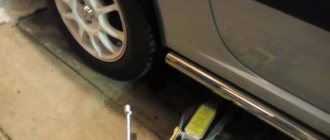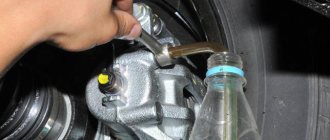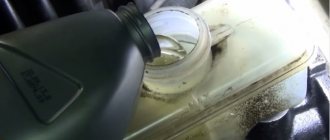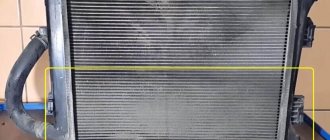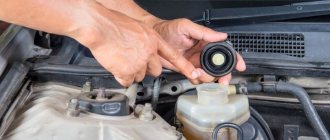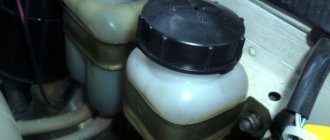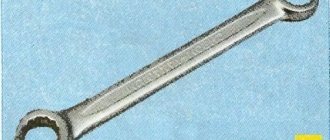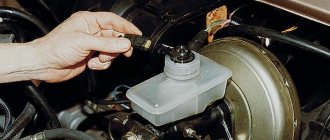One of the main systems that ensures safety when driving a car is the braking system. The most widespread are brake mechanisms that use the frictional force of different materials. Such mechanisms are installed on all cars, including VAZs belonging to the “Classic” family.
As an example of a classic VAZ, model 2107 will be used. The brake system of the VAZ-2107 includes working and parking systems. The task of the working component is to reduce the speed of movement of the car until it is completely immobilized.
It consists of two components: the first is the brake mechanisms, which act on the wheels, which is why their rotation decreases. The second component is the drive, through which the driver operates the mechanisms.
The parking component ensures that the wheels of one of the car's axles are locked, in the case of the VAZ-2107 - the rear axles, while the car is immobilized. The use of this brake prevents spontaneous movement of the car. This system uses a separate drive that acts on the rear axle mechanisms.
In more detail, what the brake system of the VAZ-2107 looks like is shown in the diagram:
Now let's take a closer look at the design of the VAZ-2107 brake system. First, let's go through the working component. Its drive is hydraulic and includes:
- Control pedal;
- Vacuum booster;
- Main cylinder;
- Tank for working fluid;
- High pressure pipelines;
- Rear axle bellows pressure regulator;
The use of liquid as a working element of the drive is due to a number of positive qualities: a complex system of levers for the drive is not required, the wiring of pipelines to the mechanisms is facilitated, the transmission of force from the driver’s foot is enhanced several times due to the vacuum booster.
The working mechanisms on the VAZ-2107 are of two types: disc brakes are installed at the front, using calipers; drum-type mechanisms are used on the rear axle, which also includes a parking mechanism.
Now in more detail about the elements of this system. So, the pedal that the driver presses is located on the same axis as the clutch control pedal. To ensure that it can be returned to its original position, it is spring-loaded.
Caliper device
Let's move on. The front axle mechanisms are disk ones, consisting of calipers with the main brake elements - pads, and brake discs.
A caliper is a body with cylinders made in it for the pistons. This model has two of them, one for each block. The support structure is shown in the figure.
The caliper pistons have the form of a glass, which is placed in their cylinders, but they can move along it. To prevent fluid leakage, the pistons are equipped with o-rings.
Pads are small metal plates onto which linings made of friction material are glued.
The brake disc is made of metal for better adhesion to the surface of the pads; its side surfaces are well processed so that there are no protrusions or shells on them.
The VAZ 2107 brakes work like this: the fluid moves into the caliper cylinders, where it begins to push out the pistons. They come out of the cylinders, pressing the pads against the disc.
Brake master cylinder
The master cylinder is connected to the booster. This element is a housing to which the supply and return pipelines from the fluid reservoir are connected, and 3 pipelines leading to the brake mechanisms exit. There is one pipeline leading to the front brake mechanisms, and only one to the rear, leading to the regulator.
Inside this housing there are pistons that push the liquid into the pipelines. One of them is connected to the amplifier diaphragm rod. These are the main elements of the drive. The detailed design of the brake master cylinder is shown above.
Vacuum brake booster
A rod connected to the amplifier is connected to the pedal. The design of the VAZ-2107 vacuum brake booster is quite interesting; it is shown in the figure:
The amplifier is a sealed container, internally divided into 2 chambers by means of a membrane. The chamber located closer to the pedal is called atmospheric, and the chamber separated from it by a membrane is called vacuum. The diaphragm itself is connected to the piston rod of the master cylinder.
The vacuum chamber is connected by a pipe to the intake manifold of the engine, where the vacuum comes from. The design also includes a follower valve controlled by the pedal rod, which does all the work.
When the pedal is released, this valve connects the chamber cavities through a channel, providing identical pressure. When the pedal is applied, the valve closes the channel connecting the chambers and opens the channel connecting the atmospheric chamber with the atmosphere. Since a vacuum is maintained in the second chamber, atmospheric pressure begins to put pressure on the membrane. Since it is connected to the piston rod of the master cylinder, due to the movement of the piston, fluid is displaced from the cylinder into the pipelines.
How to bleed the clutch on a VAZ 2107
Bleeding the clutch of the VAZ 2107, like other cars of the classic family (starting from 2101), is necessary after any operation to repair parts of its drive.
It is necessary to bleed the circuit after replacing the master or working cylinder, hose or tube, as well as when changing the fluid. The task of the manipulation is to ensure that there is no air in the clutch hydraulic drive. How to perform this procedure on a carburetor or injection car and what difficulties there may be - see the instructions.
Completion of work
At this time, there must be an assistant in the vehicle interior who will carry out the pumping process. To do this, he will need to press the brake pedal with sudden movements. In this case, it should be squeezed to the lowest position 5-6 times. After the required number of presses, the pedal must be locked in its lowest position.
The cylinder air valve should then be unscrewed 1/2 turn. This will cause the fluid to squeeze out and flow through the hose. After the brake circuit is completely released, the operating pedal in the passenger compartment will fall to the floor. After waiting until the hydraulic solution has completely flowed out, the outlet valve fitting must be tightened. A similar bleeding procedure should be repeated on the other rear wheel, and then move on to the front.
The front wheels will be drained in the same way as the rear wheels. After pumping out the remaining solution, you need to fill in new brake fluid. Before this, you need to check whether the hydraulic cylinders in the system require repair. If the movement of the working parts of the rod is smooth and without the presence of sharp twitches, then their repair is not required.
Otherwise, it is necessary to eliminate such malfunctions of the brake system or replace the hydraulic cylinder. The system should also be filled in stages, bleeding each wheel. After one side has been pumped, the solution should be added to the tank until it stops. Having pumped all the wheels, you must continue adding to the tank to the level mark indicated on its body.
After completing the repair, they check the functionality and operating efficiency of the brakes. If everything has been done correctly, the braking forces should be distributed evenly without causing delay in response. Different pad response speeds will lead to skidding during braking; this should be avoided.
Engine oil
Motor oil is the main fluid for the functioning of the engine. This is a lubricating material that reduces friction between moving parts - pistons and cylinder block. The main function of motor oil is to reduce friction between elements inside the engine and protect the engine from wear. In addition, motor oil also dissipates heat at the point of direct contact. The following requirements apply to engine oil:
— good thermal conductivity;
— the ability to withstand high and low temperatures, as well as temperature changes;
— withstand pressure up to 100 megapascals.
Unlike coolant, motor oil is made from hydrocarbons. It can be mineral, synthetic and semi-synthetic. Each type of motor oil is used for different types of engines and at different periods of wear. The circulation of engine oil inside the engine occurs thanks to an oil pump and an oil filter, which cleans the oil of carbon deposits and small metal particles.
Which brake fluid is better
Brake fluid has a significant impact not only on the condition of the braking system, but also on its effectiveness. The most important criterion when choosing a suitable TZ will be compliance with the necessary properties and requirements. But as a rule, everything is very beautifully written on the packaging of different manufacturers, but does the liquid meet the stated four basic requirements, such as: high boiling point, minimal corrosiveness, lubricating properties and stable viscosity. This can only be learned through experience and user reviews.
According to the rating carried out by the staff of the expertcen website, the best foreign-made brake fluids are: Castrol React DOT4 (price 450 rubles), Motul DOT 5.1 - will cost at least 600 rubles, Liqui Moly Bremsenflussigkeit DOT4 - 300 rubles. The list of worthy brake fluids from domestic manufacturers includes: Ros DOT-4 - 180 rubles, Sintec Super DOT-4 - 100 rubles.
But in order not to endanger yourself and other road users, you should also pay attention to those brands whose quality is not at the highest level. Among these dubious fuels are: Luxe DOT-4 (“Delfin Industry”), “ Sintec DOT-4 ” (TOV “TSKh-Khimreaktiv”) and “ Alaska DOT-4 ” (LLC “Tektro”), they are the ones that do not meet the requirements class DOT-4 according to boiling point. In addition, the Alaska DOT-4 liquid also has a deviation in viscosity at -40°C. In turn, such liquids as: “ Oilright DOT-4 ” (Tektron LLC) and Lux DOT-4 (Delfin Industry JSC) have a fairly low boiling point in a liquid that contains moisture; such parameters do not even correspond to the class DOT 3. There are also deviations to the requirements of DOT 4 for viscosity at -40°C, in liquids: PP “Lumo” (Ukraine) and Belhim DOT 4 (“BelKhimGroup”, Belarus), which is 15-25% higher than the norm.
When choosing brake fluid, you can draw analogies for a long time, read reviews, consider the list of characteristics, but at the same time you need to remember that even the brake fluid that has the best performance among others has its own service life and it must be replaced strictly according to stated regulations from the manufacturer, because your safety depends on the condition of your car .
To summarize, let's say that you only need to use the brake fluid that the car manufacturer recommends. When buying brake fluid for your car, be vigilant and be sure to pay attention to the specifications that are required for the car. If we talk about the required amount for replacing brake fluid, then, as a rule, in domestic cars it is required from 0.5 to 1 liters, while the volume of fluid in the brake system of foreign cars is from 1-1.5 liters. Therefore, when replacing and bleeding brakes, take this fact into account and always monitor the level in the expansion tank.
Brake fluid standards
In practice, and in most cases, it is customary to use the American quality standard FMVSS No. 116 (Federal Motor Vehicle Safety Standard), which was developed by the US Department of Transportation (DOT for short). So, often, in modern cars, either DOT 4 is used on a glycol basis, or DOT 5.1 (including glycol and silicone compounds). But in cars manufactured more than 20 years ago, BSK or DOT 3 fluid can be used.
The DOT standard clearly describes such characteristics as:
DOT 4 brake fluid (meets SAE J1703&J1704, FMVSS 116, JIS K2233, ISO 4925)
- degree of viscosity;
- boiling temperature;
- chemical inertness to materials (for example, rubber);
- corrosion resistance;
- constancy of properties within operating temperatures;
- possibility of lubrication of elements working in contact;
- level of moisture absorption from the surrounding atmosphere.
In accordance with FMVSS No. 116, brake fluid options are divided into five classes, each of which is designed for a specific type of operation and even the type of brake mechanisms - disc or drum.
But you shouldn’t think that these are uniform existing standards, because in Europe there will be SAE (Society of Automotive Engineers) J1703/1704 , ISO(DIN) 4925 - International Organization for Standardization, in the Middle Kingdom, Japanese - JIS (Japanese Industrial Standard) K2233 . But in Russia and other CIS countries there is no single standard regulating the quality indicators of brake fluids, so manufacturers work according to their own technical conditions.
Use of DOT brake fluids
Since in many cases everyone is guided specifically by the American DOT standard, let’s take a closer look at all five of its classes:
- DOT 3 – designed for low-speed vehicles with drum and disc front brakes. Boiling point 220° C.
- DOT 4 – is poured into the brake system of high-speed vehicles that have disc brakes on both axles. Boiling occurs at temperatures of 240° and 160° C.
- DOT 4+, DOT 4 SUPER – modifications of DOT 4, their boiling point is 260° C and 180° C.
- DOT 5 is a silicone fluid that cannot be poured into a car with an ABS system, because it does not absorb moisture, but allows it to collect in one place. Due to the fact that the boiling point is 280°C and 180°C (for “dry” and “wet” liquids) while having low viscosity, it is usually used only in racing cars.
- DOT 5.1 – for fast cars whose brakes are often overloaded. It is more high-tech and fluid than DOT 4, but still absorbs moisture. Often recommended for use in systems with ABS and ESP. Operating temperature 270°C and 180°C.
As for the service life of fluids of various classes, it should be noted that brake fluids of class DOT 3 have a service life of approximately 1-2 years , in turn DOT 4 - 2-3 years, and DOT 5.1 needs to be changed every 3-4 years . DOT 5 can be used for up to 5 years .
Volume of fluid in the brake system
Basically, the brake system holds from 0.55 to 1.0 liters of fluid, this depends both on whether the car has an ABS system and on the size of the car. The period for replacing brake fluid in most cars is 2-3 years of use, or 40-60 thousand mileage . To determine a more specific interval, you need to look at a specific fluid standard and driving characteristics. For example, in sports cars the TZ is changed every 5-10 thousand.
But since the question of the required volume of brake fluid in the system and its standard is asked only by owners of ordinary cars, and not premium or business class ones, we will give specific examples for cars popular in the CIS countries.
What and how much brake fluid is in some cars
| Fig.6 | ||
| Table of the volume of brake fluid required for replacement | ||
| car model | DOT class | Required amount of fuel fluid, l |
| Ford Focus 2 | DOT4 | 1 |
| Ford Focus 3 | DOT4 | 1 |
| Ford Kuga | DOT4 | 1 |
| Chevrolet Niva | DOT4 | 1 |
| Chevrolet Cruze | DOT4 | 1 |
| Chevrolet Lacetti | DOT 4 | 0.5 a with ABS and ESP 1.0 |
| Kia Sid | DOT4 | 1 |
| Kia Rio 3 | DOT4 | 1 |
| Kia Rio 2 | DOT 4 | with ABS - 1-1.5 l without - 1 l |
| Kia Sorento | DOT 5.1 | 1 |
| Kia Spectra | DOT3, DOT4 | 1 |
| Renault Logan | DOT 4 | with ABS – 1-1.5 l without – 0.7 l |
| Renault Duster | DOT4 | 1 |
| Renault Fluence | DOT4 | 0,5-1 |
| Renault Sandero | DOT4 | 1 |
| Renault Megane 2 | DOT4 | 1 |
| VAZ 2107, 2109 | DOT 3 | 0,55 |
| VAZ 2114, VAZ 2115 | DOT 4 | 1 |
| VAZ 2108, 2110, 2112 | DOT 4 | 1 |
| Lada Kalina | DOT 4 | 1 |
| Lada Priora (VAZ 2170) | DOT 4 | 1 |
| Lada Granta | DOT 4 | 1 |
| Lada Largus | DOT 4+ | 1 |
| Daewoo Matiz | DOT 4 | 1 |
| Mitsubishi Pajero 4 | DOT 4 | 1 |
| Mitsubishi Lancer IX | DOT 3, DOT 4 | 1 |
| Mitsubishi Lancer 10 | DOT 4 | 1 |
| Mazda Demio | DOT 3, DOT 4 | 1 |
| Mazda 3 | DOT 5.1 | 1 |
| Mazda cx 5 | DOT 4 | 1 |
| Skoda Superb II | with ABS DOT 4 | 1 |
| SKODA Octavia A5 | DOT 4 | 1 |
| Toyota RAV4 | DOT 3, DOT 4 | 0,5 |
| Toyota Corolla | DOT 4 | 1 |
| Toyota Prado 150 | DOT 4, DOT 5.1 | 1,5-1,6 |
| Volkswagen Polo sedan | DOT 4 | 1 |
| Daewoo Nexia | DOT 4, DOT 5.1 | 1 |
| Hyundai Solaris | DOT 4 | 1 |
| Hyundai Accent | DOT 5.1 | 1-1,5 |
| Volvo XC70 | DOT 4+ | 1 |
| Nissan Tiida | DOT 4 | 1 |
| Nissan Qashqai | DOT 4 | 1 |
| Nissan X Trail | DOT 3, DOT 4 | 1 |
Why is it impossible to bleed the clutch of a VAZ-2107
The reason why you cannot bleed the clutch on a VAZ 2107 may be:
This condition of the clutch cylinders can cause unsuccessful bleeding. It will block the fluid supplied to the working cylinder installed on the gearbox
- clogging of the hydraulic circuit;
- malfunction of the hydraulic drive cylinders;
- bending of the hose or circuit tube;
- air intake from outside.
To solve the problem, you need to inspect the circuit for kinks and/or leaks. If they are, the hose or tube should be corrected/replaced. If not, try to blow out the circuit and change the fluid. To do this, you need to open the fitting, drain the old fuel fluid by pumping or pressure, unscrew the fitting completely and blow out the circuit with a pump or compressor.
To make the connection, you can use a tank plug with a hole into which the tubeless tire nipple is inserted. This cap must be screwed on instead of the original one, connected to a pump or compressor and supplied with air pressure. It will blow out all deposits through the fitting hole.
Then you need to screw in the fitting, fill in fresh fluid and pump the circuit according to the instructions. Bleeding the clutch on a VAZ 2107 should be done using one of the methods described above. If this does not help, you need to diagnose the cylinders and replace the faulty part with a new one.
Source
